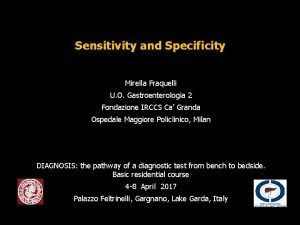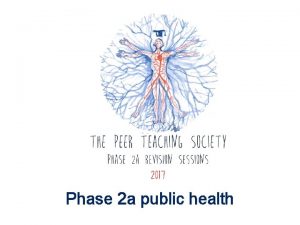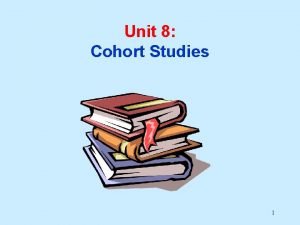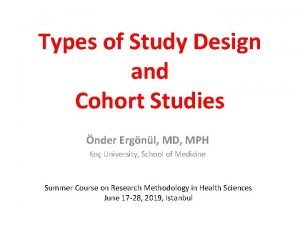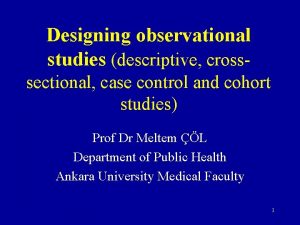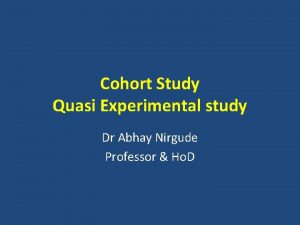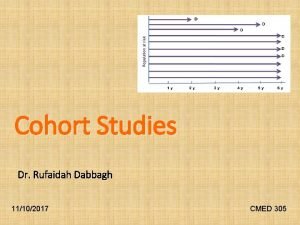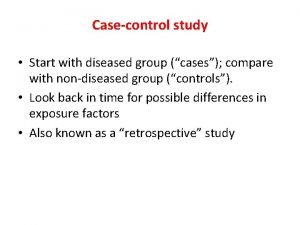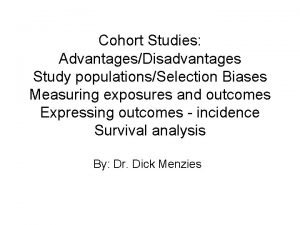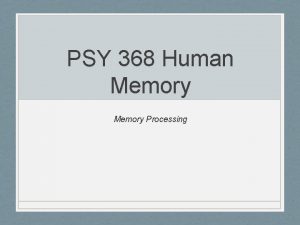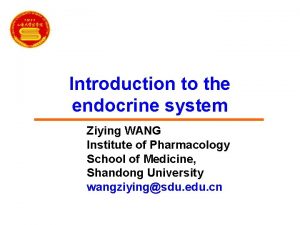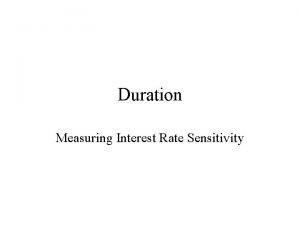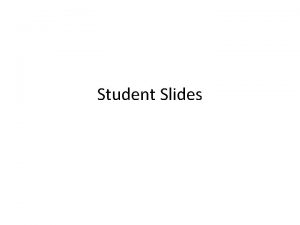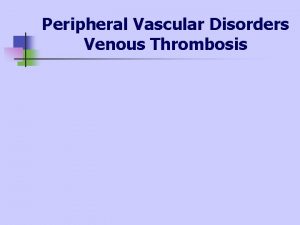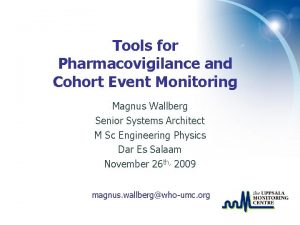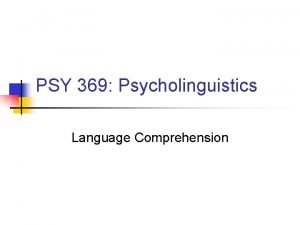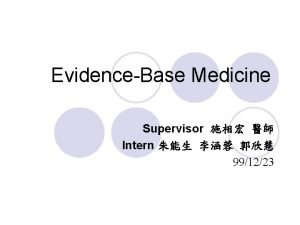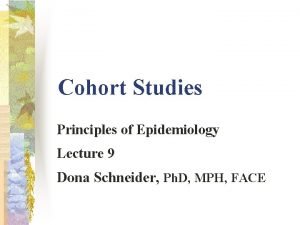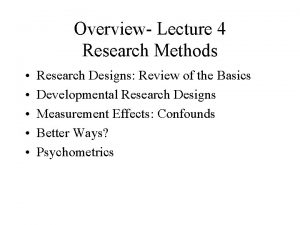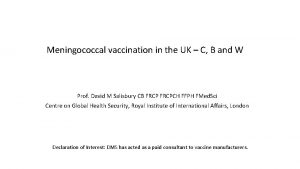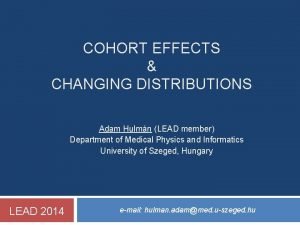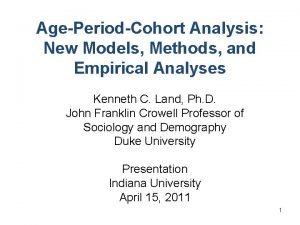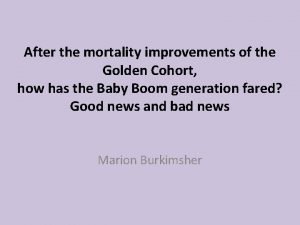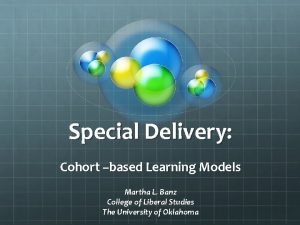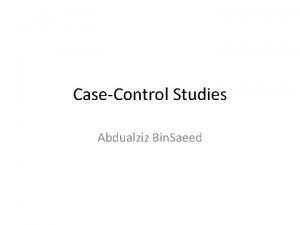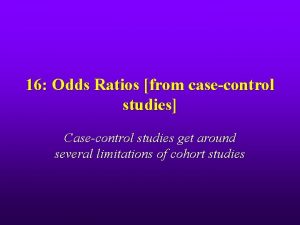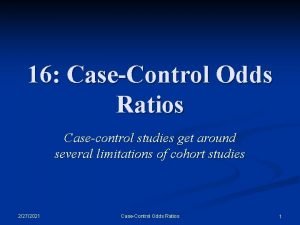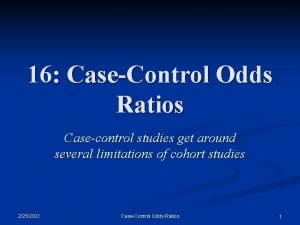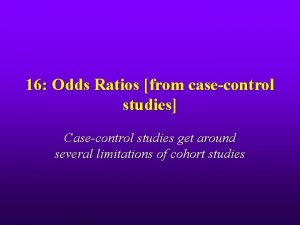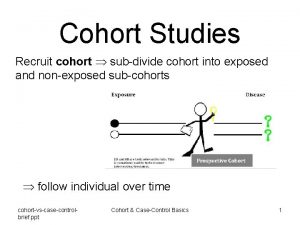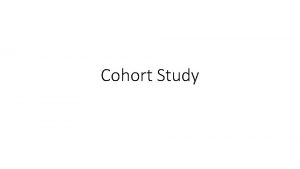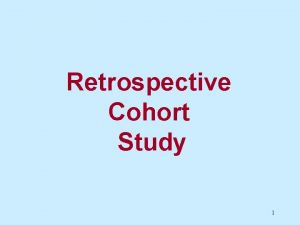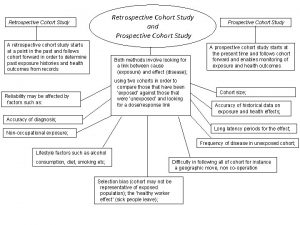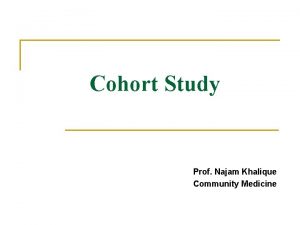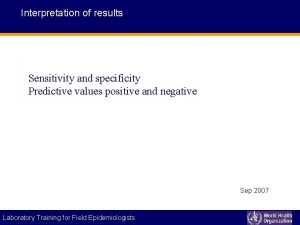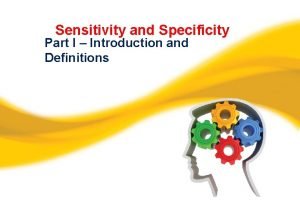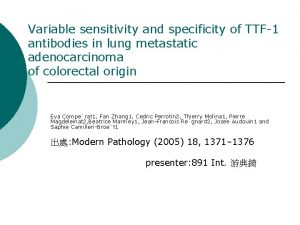Risk Cohort study Casecontrol study Diagnosis Sensitivity specificity




![Grade of Recommendation Level of Therapy Evidence [A] 1 a Systemic review of RCTs Grade of Recommendation Level of Therapy Evidence [A] 1 a Systemic review of RCTs](https://slidetodoc.com/presentation_image_h/7924b56a22327a0db6e7c1a519ab79cc/image-5.jpg)





![Grade of Recommendation Level of Therapy Evidence [A] 1 a Systemic review of RCTs Grade of Recommendation Level of Therapy Evidence [A] 1 a Systemic review of RCTs](https://slidetodoc.com/presentation_image_h/7924b56a22327a0db6e7c1a519ab79cc/image-11.jpg)



































- Slides: 46


臨床問題的類型 • 危害或致病因子探討(Risk) – Cohort study – Case-control study • 診斷(Diagnosis) – Sensitivity, specificity – Predictive value (PPV, NPV) • 治療(Therapy) – Clinical trial • 預後(Prognosis) – Prediction model, simulation model

The best evidence depends on the type of question • What is frequency of the problem? (Frequency) – Random (or consecutive) sample • Does this person have the problem? (Diagnosis) – Random (or consecutive) sample with gold standard • How can we alleviate the problem? (Therapy) – Randomized controlled trial (RCT) • Who will get the problem? (Prognosis) – Follow-up of inception cohort

The Evidence Pyramid Randomized Controlled Studies Cohort studies Case Control Studies Case series/ Reports Ideas, Editorials, Opinions Meta-analysis Forest plot Animal research In vitro (test tube) research Hierarchy of evidence that arranges study designs by their susceptibility to bias. Meta - analysis Randomized Controlled Double Blind Studies
![Grade of Recommendation Level of Therapy Evidence A 1 a Systemic review of RCTs Grade of Recommendation Level of Therapy Evidence [A] 1 a Systemic review of RCTs](https://slidetodoc.com/presentation_image_h/7924b56a22327a0db6e7c1a519ab79cc/image-5.jpg)
Grade of Recommendation Level of Therapy Evidence [A] 1 a Systemic review of RCTs 1 b Single RCT 1 c ‘All-or-none’ 2 a Systemic review of cohort studies 2 b Cohort study or poor RCT 2 c ‘Outcomes’ research 3 a Systemic review of casecontrol studies 3 b Case-control study [C] 4 Case series [D] 5 Expert opinion, physiology, bench research [B] Evidence-Based Medicine: How to Practice and Teach EBM. 2 nd ed. David L. Sackett, Sharon E. Straus, W. Scott Richardson, William Rosenberg, R. Brian Haynes. Churchill Levingstone. 2000, p 173 -177

IN Our case ~ What’s the Question? • Dose sonography or CT the best tool for diagnosis intussusception

PICO desigh • Population: patient with the clinic symptom wiht intussusception • Intervention: sonography for diagnosis • Comparison: CT for diagnosis • Outcome: Accuracy rate



The Evidence Pyramid Randomized Controlled Studies Cohort studies Case Control Studies Case series/ Reports Ideas, Editorials, Opinions Meta-analysis Forest plot Animal research In vitro (test tube) research Hierarchy of evidence that arranges study designs by their susceptibility to bias. Meta - analysis Randomized Controlled Double Blind Studies
![Grade of Recommendation Level of Therapy Evidence A 1 a Systemic review of RCTs Grade of Recommendation Level of Therapy Evidence [A] 1 a Systemic review of RCTs](https://slidetodoc.com/presentation_image_h/7924b56a22327a0db6e7c1a519ab79cc/image-11.jpg)
Grade of Recommendation Level of Therapy Evidence [A] 1 a Systemic review of RCTs 1 b Single RCT 1 c ‘All-or-none’ 2 a Systemic review of cohort studies 2 b Cohort study or poor RCT 2 c ‘Outcomes’ research 3 a Systemic review of casecontrol studies 3 b Case-control study [C] 4 Case series [D] 5 Expert opinion, physiology, bench research [B] Evidence-Based Medicine: How to Practice and Teach EBM. 2 nd ed. David L. Sackett, Sharon E. Straus, W. Scott Richardson, William Rosenberg, R. Brian Haynes. Churchill Levingstone. 2000, p 173 -177

搜尋結果 (2) 篇數 Meta-analysis 0 文獻 0 RCT 0 Cohort 0 Case control 1 study Case-series 0 證據等級 3 a

The imaging of intussusception A. T. Byrnea, T. Goeghegana, P. Govendera, I. D. Lyburnb, E. Colhouna, W. C. Torreggiania, * Clinical Radiology (2005) 60, 39– 46 PICTORIAL REVIEW

Introduction(1) • Intussusception occurs when one segment of the gastrointestinal tract telescopes into an adjacent segment. • Most intussusceptions occur 3 m/o to 3 y/o • Male dominance of 3: 2 • the most common cause of an acute abdominal emergency in childrend

Introduction(2)

Introduction(3) • The classic triad: 1. pain 2. red currant jelly stool 3. palpable mass 50% patient have • There is a higher incidence in spring and autumn • viral infection?

Introduction(4) • In adults, an underlying cause is present in 80% of cases • tumours , polyps , oedema , fibrosis , recent or previous surgery • 20% of cases are idiopathic • ileocolic junction paediatric population • entero-enteral type adults

Imaging of intussusception Plain radiographs

Plain radiographs() • The first report of intussusception diagnosed radiographically was by Lehmann in 1914 • soft tissue density 60% of patients • Crescent sign ileocolic or colocolic

• Plain radiograph of a young child with proven intussusception. • There is a soft tissue density in the mid abdomen, representing the intussusception (arrow).

Plain radiographs() • Although plain films are useful, they lack sensitivity and many false negatives occur • even plain radiographical negative need to perform ultrasound

Imaging of intussusception Barium and contrast studies

Barium and contrast studies • Traditionally, a contrast enema was considered the most reliable test for intussusception in children. • Performed: 1. stabilizing the clinical condition 2. full discussion with a (paediatric)surgeon

• (a) Barium study showing a filling defect within the bowel at the level of the hepatic flexure, representing the site of intussusception in a young child. • (b) After reduction contrast medium is demonstrated in the small bowel. A filling defect is due to an oedematous iliocecal valve (arrow).

Barium and contrast studies • Therapeutic: Previously : barium reduction barium peritonitis. Current : air reduction safer, cheaper and more effective

• Air contrast enema in a young child during air reduction, showing a soft tissue mass representing an intussusception at the level of the hepatic flexure. • The intussusception was successfully treated by air reduction.

Barium and contrast studies • False positives are more common in adults with masses within the colon sometimes simulating an intussusception

• Contrast enema study in an elderly patient with intermittent large bowel obstruction. • (a) Initial film demonstrates soft tissue density and concentric rings, initially thought to be an intussusception. • (b) Delayed films demonstrate that the was a large faecolith (arrow).

Imaging of intussusception Ultrasound

Ultrasound • experienced hands: sensitivity and specificity particularly true in children • non-invasive, easy to perform and reproducible • Classic findings on transverse scanning include a so-called “target lesion” or “doughnut sign”, with the presence of several concentric rings

• Transverse ultrasound imaging showing the classic “doughnut sign” of the concentric rings of intussusception.

• On longitudinal imaging, multiple thin parallel stripes of varying degrees of echogenicity with a sandwich-like appearance are typically seen, the so-called pseudokidney sign

• Longitudinal ultrasound images demonstrate bowel intussusception imitating the adjacent normal kidney. • This is termed the “pseudokidney” sign.

• false positives : secondary to conditions such as lymphoma or an inflammatory mass adult • In addition, if there is abundant overlying bowel, false negative results may be obtained.

Imaging of intussusception Computed tomography

Computed tomography • computed tomography (CT) is normally not indicated in children, • It is however useful in adults in both making the diagnosis and assessing for an associated underlying cause

• Lead point • Target sigh • sausage-shaped

• Elderly patient with rectosigmoid intussusception secondary to rectal cancer. + (a) CT at rectosigmoid level demonstrates typical intussusception with inner intussusceptum (black arrow) and outer intussuscipiens(white arrow). (b) CT at a lower level demonstrates a central lead point representing a rectal carcinoma (arrow). (c) Following rectal examination, there was prolapse of the rectum with clear demonstration of focal tumour

• Contrast-enhanced CT showing a target lesion in a person with jejunal intussusception. • The arrow represents the intussusceptum.

• Elderly patient with proven intussusception. CT demonstrates a sausageshaped mass at the site of an ileocolic intussusception (arrow). • The patient has associated small bowel obstruction.

Imaging of intussusception Magnetic resonance imaging

• HASTE (half-fourier single shot turbo spin echo) imaging useful in the evaluation of intussusception. • MRI’s multiplanar ability allows precise localization of the segment of bowel involved • MRI is reserved for adult patients who are not acutely ill.

• MRI was performed to try to identify an underlying lead point. (a) Axial multiplanar HASTE (half-fourier spin turbo echo, TRZ 1100, TEZ 110) imaging showing intussusception in the bowel adjacent to the right kidney. (b) and (c) Coronal HASTE images showing the target (arrow) and sausage shapes of the intussusception. A lead point was not identified in this case at imaging. The diagnosis of myofibroblastic tumour was made at surgery.

Conclusion • In the paediatric group ultrasonography is highly sensitive and specific in experienced hands initial treatment is often by radiological reduction.

Conclusion • In the adult population, CT and MRI play a more important role in the detection and evaluation of intussusception Treatment in this group is usually surgical and an underlying cause is found in most cases.

Thanks for your attention!
 Retrospective cohort study vs prospective cohort study
Retrospective cohort study vs prospective cohort study Sensitivity specificity mnemonic
Sensitivity specificity mnemonic Sensitivity specificity ppv npv
Sensitivity specificity ppv npv Case series
Case series Liquidity measures
Liquidity measures Cohort study example
Cohort study example What is a cohort study
What is a cohort study Retrospective cohort study vs case control
Retrospective cohort study vs case control Quasi experimental design
Quasi experimental design Retrospective cohort study
Retrospective cohort study Cohort study community medicine
Cohort study community medicine Longitudinal prospective study
Longitudinal prospective study Case control study example
Case control study example Biases in cohort studies
Biases in cohort studies Cohort study definition
Cohort study definition Levels of processing theory
Levels of processing theory Geometric specificity
Geometric specificity Memory stages model
Memory stages model Hormone specificity
Hormone specificity Prinsip latihan overload
Prinsip latihan overload Interest rate sensitivity analysis
Interest rate sensitivity analysis Sensitivity analysis interest rate risk
Sensitivity analysis interest rate risk Step of nursing process
Step of nursing process Medical diagnosis and nursing diagnosis difference
Medical diagnosis and nursing diagnosis difference Medical diagnosis and nursing diagnosis difference
Medical diagnosis and nursing diagnosis difference Medical diagnosis and nursing diagnosis difference
Medical diagnosis and nursing diagnosis difference Perbedaan diagnosis gizi dan diagnosis medis
Perbedaan diagnosis gizi dan diagnosis medis Nursing diagnosis for poor nutrition
Nursing diagnosis for poor nutrition Virchow's triad definition
Virchow's triad definition Nursing diagnosis examples nanda
Nursing diagnosis examples nanda Cem in pharmacovigilance
Cem in pharmacovigilance Puldow cross
Puldow cross Cotrizine
Cotrizine Types of cohort studies
Types of cohort studies Jinyun yan
Jinyun yan Summary lean startup
Summary lean startup Demographic cohort
Demographic cohort Sequential research design
Sequential research design Cohort model
Cohort model Picme2.0
Picme2.0 Cohort effects definition
Cohort effects definition Cohort effects definition
Cohort effects definition Golden cohort
Golden cohort Cohort event monitoring
Cohort event monitoring Students cohort
Students cohort Cohort adalah
Cohort adalah Cohort based courses
Cohort based courses

